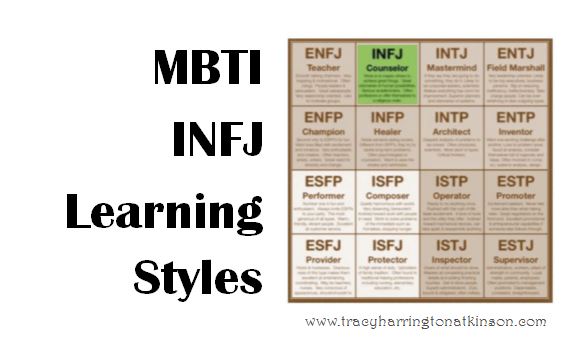INFJ (Introversion, Intuition, Feeling, Judging) Learning Style
Seek meaning and connection in ideas, relationships, and material possessions. Want to understand what motivates people and are insightful about others. Conscientious and committed to their firm values. Develop a clear vision about how best to serve the common good. Organized and decisive in implementing their vision.
~Excerpted from Introduction to Type®
by Isabel Briggs Myers
_______________________________________________
Frequency
| INFJ – | 1.5% of the total population |
| 1.3% of the male population | |
| 1.6% of the female population |
| Introversion (I) | 50.7% of the total population |
| Intuition (N) | 26.7% of the total population |
| Feeling (F) | 59.8% of the total population |
| Judging (J) | 54.1% of the total population |
_______________________________________________
The estimated frequency table was compiled from a variety of MBTI® results from 1972 through 2002, including data banks at the Center for Applications of Psychological Type; CPP, Inc; and Stanford Research Institute (SRI).
Learner Keyword: reflective and connectionist1
Learner Question
INFJs, while learning, address the question, “Is it good for people?”2
Learning Style
INFJs are energized by making connections between people, feelings, values and knowledge. They are visionaries who are future-oriented, always seeking and looking at possibilities. The often think metaphors.
INFJs are task-oriented learners who enjoy making connections, recognizing relationship between information. They enjoy playing with ideas and possibilities.
INFJs seek the purpose of learning to be for personal growth and development.
Cognitive Environment
INFJs like a structured learning environment which is task-oriented. They prefer to learn through independent options. Any group option or partnership is stressful for INFJs.
INFJs prefer a teacher-centered classroom where this is no opportunity for them to be the center of attention. Therefore, lectures are valuable to this learner.
INFJs need time to reflect. They enjoy reading and learn easily from this methodology.
Friendly and cooperative environments are more conducive for learning for the INFJs than competition and disharmony.
INFJs need time to not just to reflect but to generate ideas and to use their imagination.
INFJs are most comfortable:
- Knowing what they will be learning prior to class -such as a preview
- Independent work
- Structure
- Reading and solitary study times
- Learning abstract information
- Creativity, inspiration -having time to generate ideas
- Observing
INFJs are least comfortable:
- Unstructured learning environments
- Simple answers – INFJs are skeptical of simplicity.
- Facts and figures, statistics
- Confining assignments which do not allow space for creativity and innovation
- Being the center of attention
- Being volunteered to answer or participate without sufficient time to think or preparation time
Learn More:
For more information on teacher and classroom tips, learner tips, instructional strategies and assessment strategies, see MBTI Learning Styles: A Practical Approach or learn more on Udemy.
Click on one of the sixteen personality types for more information:
Click on one of these dimension for more information:

For other learning styles: MBTI Learning Styles – A Practical Approach Available in paperback; Kindle; and pdf versions
For other learning styles: MBTI Learning Styles – A Practical Approach Available in paperback; Kindle; and pdf versions
References
Bonwell, C. & Eison, J. (1991). Active Learning: Creating Excitement in the Classroom. ERIC Digest. ERIC Clearinghouse on Higher Education, Washington, D.C
Career Assessment. (2017). The 16 Myers-Briggs Type Indicator Personality Types (MBTI personality types). Retrieved from: http://careerassessmentsite.com/tests/myers-briggs-tests/about-the-myers-briggs-type-indicator/the-16-myers-briggs-personality-types/
CPP, Inc. (2017). Linking MBTI® Personality Type to Learning Style – Strategies and Insights. Retrieved from: http://www.cppblogcentral.com/cpp-connect/linking-mbti-personality-type-to-learning-style-strategies-and-insights/
Defiance College. (2106). What’s Your Personality Type? Retrieved from: http://library.defiance.edu/learningstyles/myersbriggs
Gregory, G. (2008). Differentiated instructional strategies in practice: training, implementation, and supervision (2nd ed.). Thousand Oaks, CA: Corwin Press. p. 97-99.
Humanmetrics. (2017). Learning Styles. Retrieved from: http://www.humanmetrics.com/personality/learning-styles
Kiser, H. (2017). Choice board. Retrieved from: https://hillarykiser.blogspot.com/2012/10/choice-board.html?showComment=1491939410939#c9063789945839625994
Krafka, K. (2017) Learning Menus. Retrieved from: http://prescriptionforgiftedsuccess.weebly.com/learning-menus.html
Litemind. (2017). What is mind mapping? Retrieved from: https://litemind.com/what-is-mind-mapping/
Martinez, M. (2006). What is metacognition. Phi Delta Kappan, 64(10), 696-699.
Melvin, J. (2017). Personality Type as an Indicator of Learning Style. University of Rochester. Retrieved from: file:///C:/Users/Tracy/Downloads/JMelvinSGf13paper%20(2).pdf
Myers & Briggs Foundation. (2017). How frequent is my type? Retrieved from: http://www.myersbriggs.org/my-mbti-personality-type/my-mbti-results/how-frequent-is-my-type.htm
Myers & Briggs Foundation. (2017). Type and Learning. Retrieved from: http://www.myersbriggs.org/type-use-for-everyday-life/type-and-learning/
Myers, I. (1998). Introduction to Type: A Guide to Understanding Your Results on the MBTI Instrument. Consulting Psychologists Press.
Myers, I., McCaulley, M., Quenk, N. & Hammer, A. (2009). MBTI Manual: A Guide to the Development and Use of the Myers-Briggs Type Indicator Instrument. Consulting Psychologists Press.
Okoro, C. & Chukwudi, E. K. (2011). Metacognitive skills: A viable tool for self-directed learning. Journal of Educational and Social Research, 1(4), 71-76.
Pelley, J.W. (2008). The Success Types Learning Style Type Indicator. Retrieved from: Texas Tech University. https://www.ttuhsc.edu/som/success/lsti.aspx
Smith, C. V. & Cardaciotto, L. (2011). Is active learning like broccoli? Student perceptions of active learning in large lecture classes. Journal of the Scholarship of Teaching and Learning, 11(1), 53-61.
University of Texas. (2017). Experiential Learning. Retrieved from: https://facultyinnovate.utexas.edu/teaching/strategies/overview/experiential-learning
Western Nevada College. (2017). Personality Types and Learning. Retrieved from: http://www.wnc.edu/mbti/personality-types/
Tracy Atkinson is certified in Myers Briggs Type Indicator (MBTI) by CPP, Inc. The findings on learning styles derive from research, experience and observations.
Tracy Atkinson, a mother of six, lives in the Midwest with her husband and spirited dachshunds. She is a teacher, having taught elementary school to higher education, holding degrees in elementary education and a master’s in higher education. Her passions include researching, studying and investigating the attributes of self-directed learners. She has published several titles, including: The Art of Learning Journals, Calais: The Annals of the Hidden, Rachel’s 8 and Securing Your Tent. She is currently exploring the attributes of self-directed learners: The Five Characteristics of Self-Directed Learners.


Comments are closed